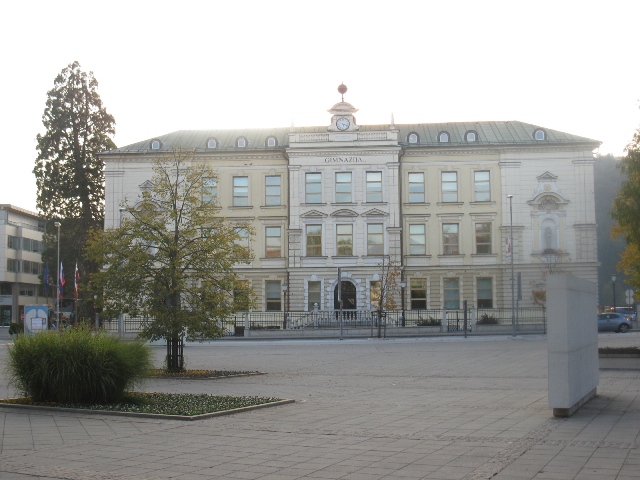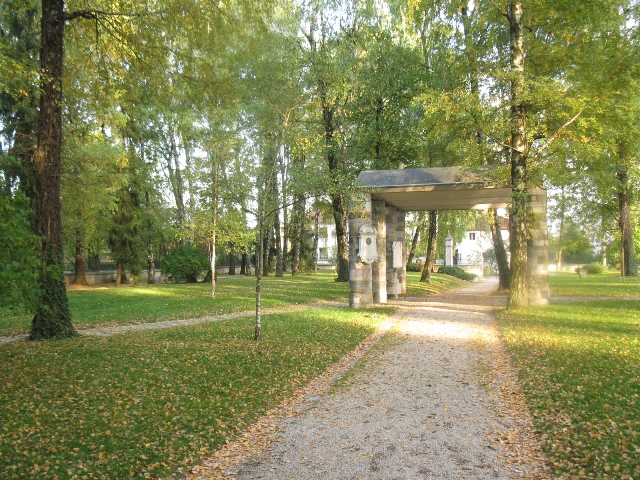Some time ago I got a few old, hand drawn, postcards from Kranj, which reflected a simpler time. A time, when houses were build exclusively from stone and the streets were paved with little blocks and you could see a lot more of forests and a lot less of concrete. I got nostalgic for good old days I've never, as a child of the 90s, experienced. Thus I've decided to go and visit this really old and beautiful Slovenian town. In the mighty company of Britannia, Mother Russia and Uncle Sam is our Kranjski Janez an image, that represents our small nation and I wanted to see, what is so all-Slovenian there, to be so typical of our land that it could personify the nation.
Sava silently flows…
Ever since the times of Ancient Rome there has been a town on the rock where Kokra flows into Sava, with majestic Alps in the background and the fertile plains to the south. The town has had many names, from the Latin Carnium, then German Krainburg and now Kranj. The very image of the town reviles its historical roots. There’s the mighty medieval castle which engulfed the ruins of the old Roman settlement, and all the way to the mighty chimneys of Yugoslavian industrialization at the railroad station and the hydro plant, pulling water from Sava… concluding it all with contemporary architecture. The latest can be seen in one of the best libraries of Slovenia, with glass walls in the renovated Globus building (otherwise covered with colourful but lame rusted tiles) are showing off several floors of gathered human knowledge and storytelling. In the centre of the town we can (on the almost same street) see the muscular statues of men and women, celebrating the communistic ideal and narrow medieval buildings, from where they were throwing the muck of their bed pans to the cobbled street. The town is also proud of its grammar school, the final resting place of Slovenia’s greatest poet and a rather decent football stadium.

It will be the memory of my wounds and your praise
We need to devote a word or two to the literary history of Kranja, as the centre of the region Kranjska, one of the territories of the Holy Roman Empire. The territory the only Slovenian who was ever accepted into the London royal society, Janez Vajkart Valvasor, wrote about. And finally as the final resting place of France Prešeren, the myth among Slovenian poets. Hearing the vicious rumours about the park Prešernov gaj, one would almost expect the sound of crunching needles under the feet and joints instead of dry leaves in the autumn months. But it really is a decent park with the graves of famous town’s people at the wall. Still, there are many young people keeping Prešeren company, looking for inspiration. Unlike Prešeren, though, they are not getting their inspiration from young muses, but in the druggy mists. Apart from Doctor Fig (Prešeren’s nickname), Kranj is also the home of Janez Mencinger, who used to be the boss of the great realistic writer Ivan Tavčar and also Simon Jenko (who’s also found the last resting place along Prešeren). For a few years it was also the home of Jože Plečnik. But setting the lawyers, poets and architects aside, the probably most important cultural descendent of Prešeren is the comedian Boštjan Gorenc – called pyjama. He’s translating the fantasy saga: The song of ice and fire.

The metropolis of Gorenjska?
One would expect the fourth largest Slovenian city to be a vibrant cultural, political and party centre, but it’s not. There are some night clubs and nacre paths, the youth really has no place to go, except for occasional cultural events at the old pool and the stylistic cinema now owned by the Kolosej. It was built in the style of grand US cinemas of the golden days of black and white films. OK, you can rest your feet in one of the many cafes, but there is no big city light glamour, still Kranj is a town well worth seeing. The underground tunnels, the urbanized dance of decaying factories and trees, the walking paths along the river Kokra and over small island towards Sava and the medieval romantic centre of the town, with ivy covering colourful old houses, are just a few of the reasons why you should devote an afternoon to walk through this place.
So is Kranj the personification of our nation, worthy to hold the name of the famous sausage (Kranjska klobasa)? It may not be the most metropolitan city of Slovenia (can’t compare to Ljubljana or Maribor), but it still represents the development of our nation. There are Roman foundations, which are still visible, but the streets reflect the church control of the medieval centuries. The decaying industrial areas, slowly getting overgrown with grass and shrubs show the economic strength of Yugoslavia and many ambitious architectural projects like the renovation of the Globus and placing three commercial buildings half way in the hill and half way in mid-air are showing the willingness to embrace the future with both hands. So Kranj really may be the all Slovenian town. It’s a model of what cities should be: multicultural, multigenerational, industrial and cultural centre, where new ideas for the future are born and where families find the secure environment to work and raise their children.